BLACK SOCIAL HISTORY ALBINOS IN AFRICA
Albinism is a rare, non-contagious, genetically inherited condition occurring in both genders regardless of ethnicity, in all countries of the world. BOTH the father and mother must carry the gene for it to be passed on even if they do not have albinism themselves.
Black woman,White skin Kenosha Robinson an albino on the fashion page of
Marie Claire Magazine http://www.marieclaire.com/world-reports/news/black-white-skin
The condition results in a lack of pigmentation in the hair, skin and eyes, causing vulnerability to sun exposure and bright light. Almost all people with albinism are visually impaired, with the majority being classified as “legally blind”. While numbers vary, in North America and Europe it is estimated that 1 in every 20,000 people have some form of albinism.
b Mother and her Albino Child
In Africa albinos have been facing persecution and discrimination whiles some other African state also see nothing wrong with people living with albinism. In some African Culture and tradition albinism is a sign of bad luck in the family and as a result they are ostracized from the family to avoid being ridiculed by the other members of their community.Among the Mandinke people of Mali a child born with albinism is an ill-omen and a shame to the family. It is even seen as a curse and that child is not allowed to come anywhere near their own family and is in the view of this that is why Malian renowned singer dubbed "the Man with the Golden Voice and inventor of Afro-pop" music Salif Keita was ostracized from his family despite being born of royal blood as a direct descendant of the founder of the Malian State, Sundiata Keita.
Malian Albino singer, Salif Keita
In Ghana,albinos are called "Ofiri Djato" (fair person) which is quite different from how they call a caucasian/white person as "obroni." Albinos in Ghana don`t face any persecution at all. There are some how are even very influential in the national affairs. A celebrated legal luminary and the long time president of Ghana Boxing Association (GBA),Moses Foh-Amoaning is a well-known albino who easily mingles with people in Ghana without any discrimination.
Attorney Moses Foh-Amoaning,Ghana`s leading Sport Analyst
Among the Akans in Ghana albino is just like any other Akan with different skin i.e black person in white skin. As young people there was this mystery story about albinos that they do not die but just get translated out of this world. It is also believed that the great Okomfo Anokye, the priest that conjured the Golden Stool for the Ashanti kingdom and is also a co-founder of Ashanti kingdom was an albino (Ofiri). Albinism in Akan culture is well understood that there is even a great deity of worship in one Akan community (i.e the Brongs) that bears the name " Kwaku Firi shrine" at Anwoase (Kwaku the Albino).


It is therefore wrong for the international community and some foreign media to treat Africa as if it is a continent that is barbaric and they just take joy in persecuting and discriminating against people living with albinism. One can only do a meaningful analysis of the problem that albinos are facing from the get rich mentalities of the youths of today in Africa who via what they see on the media are bent on using any means to get rich quicker. It is this "get rich or die trying" mentality that has also make the albinos become an endangered species in Africa as some "juju/medicine men" claims albinos blood and body-parts are very potent for rituals and can bring one instant wealth and luck.
An albino Royal in procession with his Akan Chieftaincy retinue
Now before I get into types of albinism and issues of albinos in Africa, let us ponder if albinos are the the species of homo sapiens that caucasians originated from?
Albinos--The Origin of the Caucasian Race?
As new information comes down the pike, it is necessary to rethink theories that were once in place. The origin and labeling of the “so called” Caucasian, Negroid, and Mongoloid Races by 19th Century scientists, started racial groupings based on skin color by naturalists and anthropologists like Johann F. Blumenbach, JA Gobineau and HS Chamberlain. These men also equated skin color to psychological value and importance to race. Blumenbach named whites after the Caucasus Mountains because he thought the purest white people originated there. He didn't seem to realize the following:
Russia, Chechens, Armenians, and other Southern Russians are considered to have Black Negro origins and Caucasus Mountains people are classified as "black" and are discriminated against. Blacks have lived in Southern Russia since prehistoric times and have occupied the Black Sea Region since the time of Senwosret/Sesostris (2000 BC) when Africans dominated the region. (SEE 'HERODOTUS' ON THE COLCHIANS).

Albino woman

Albino woman
FROM AFRICA – NOT TO AFRICA!
Today The American Anthropological Association declares there is no such thing as race which is merely a “social construct.” If that is the new scientific principle, then….There are plenty of scientific facts to back up this principle. According to The South African Institute for Medical Research in review – Journal of South African Science, THE HIGH FREQUENCY OF ALBINISM IN AFRICA provides more clues to early African history. The Department of Human Genetics at the SAIMR is currently involved with numerous research projects, most related to human genetic disorders and population origins--one of these, ‘Albinism in African peoples’ having received particular attention because it offers new insights into the historical movement of peoples in sub-Saharan Africa.


The albinism syndrome shows parallels with sickle cell anemia. The carrier of the sickle cell mutation is at an advantage in regions where malaria is hyperendemic, which includes large areas of Africa.


BaAka mother with albino son. The BaAka (also called the Bayaka or Aka) are a nomadic people of the Western Congo Basin in Central Africa. They are part of the wider grouping of Mbenga people, historically called pygmies. Albinism is a genetic disorder characterized by a lack of the pigment melanin, which gives colour to the skin, hair and eyes. Those affected are known as albinos. Photographed in the south-western region of the Central African Republic. Credit: TONY CAMACHO/SCIENCE PHOTO LIBRARY
About one in 35 southern African blacks is a carrier of an albinism mutation, a surprisingly high prevalence for a genetic disorder where the homozygote is at a survival disadvantage. It is postulated that the albinism carrier may actually be at an advantage, possibly also with malaria as the selective agent. It has been suggested that mosquitoes are less likely to alight and take blood from a lighter-skinned person and thus the albinism carrier may be at an advantage over darker-skinned people. The testing of this hypothesis is opening up a new line of research into malaria studies, which may yet show some other selective agent may be responsible for the high frequency of albinism in Africa.
The new scientific genetic information derived from the Human Genome Project, an international effort to decode the information embedded in the human genome, confirmed to the world by scientists in the East Room of the White House (June, 2000). We all evolved in the last 100,000 years from the same small number of tribes that migrated out of Africa and colonized the world". "All human beings are 99.99% the same at the DNA level and the remaining 0.1% genetic variation that exist seldom segregate in a manner that confirms to the racial boundaries constructed by social political means.”
Many years before the Human Genome's Project announcement of its historical DNA findings on so called "race" (in June of 2000), historians have revealed that human beings, during the primitive era in ancient/antiquity Africa - The Origin of Humankind/Humanity states that due to the lack of knowledge about inbreeding (between closely related parents) they did not understand why their off spring were born with "white skin." Scientists say "white skin" is a form of Albinism (a genetic defected offspring -- lacking melanin).
Cystic Fibrosis was thought to be a disease that affects mostly Europeans, but there are studies that now confirm that the most likely origin of the mutation is the African Continent.


The CF studies also tie-in with population migration investigations. Since the common African mutation has also been found in Zambia and Cameroun, it too supports the Bantu Expansion Hypothesis. It is worth noting that the mutation has also been found in African-Americans, in Saudi Arabia and in Greece on the same chromosome background (haplotype), suggesting a single origin. The most likely origin of the mutation is indeed the African Continent.
Cystic fibrosis (CF) was first described in Europe in the late 1930s. It was later shown to be surprisingly common with, on average, one in 20 individuals of European origin carrying a CF mutation. It was widely believed to be absent or very rare in Black Africans and was taught as such to generations of medical students. Only a handful of cases were described in African Blacks in a period of over thirty years, although it was well documented among African-Americans. CF was originally thought to be present in the latter because of admixture with individuals of European descent.
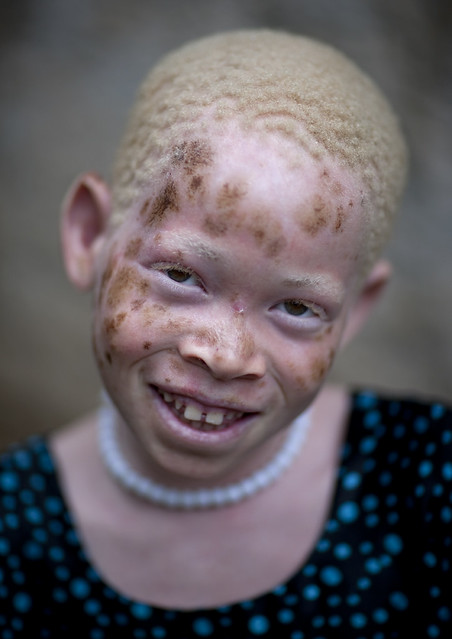
Albino girl
Oculocutaneous albinism (OCA) is a rare, genetically inherited condition passed on by both parents to their offspring, resulting in a significant reduction in or absence of pigmentation in the hair, skin, and eyes at birth. Individuals with albinism are very fair-skinned and fair-haired, with (most often) blue eyes that can take on tones of purple or red in bright lighting.
But due to such lack of knowledge as to why their "white skinned" off springs came about, African mothers and fathers became more and more fearful and suspicions and began to separate their growing number of "white skinned" off springs away from the "black skinned" (pigmented) population.
Eventually most of the "white skinned" off springs of "African" mothers and fathers formed several groups and began to migrate northward through Egypt to another area of Africa which is now called Europe, seeking a more hospitable living environment and to escape the intensity of the equatorial hot climate of the great river valleys and great lakes region of Central, Eastern and Southern Africa which was then and still is South of what is now called Egypt.
The "albino" group moved up in the mountainous area during the Ice Age or Glaciations period that lasted thousands of years further isolating themselves from their original parent population in Africa. And by being in such isolated living condition for such a prolonged period they also interbred (within the existing parent groups) thereby creating additional "albino" offspring from "albino" mothers and fathers who were then and still are direct descendents of African mothers and fathers.
A mutation results in a change of the DNA sequence within a gene or chromosome of an organism resulting in the creation of a new character or trait not found in the parental type. There is blonde hair among the black Australian aborigines. That is an example of a mutation. Albinism is a good example of a mutation. Other examples of mutations are blondism or whiteness among monkeys, apes, and chimpanzees.
Biblical Evidence of White Skin
There are many cases of individuals turning white in Jewish biblical history. When God wanted to show Moses a miracle, he turned his hand "white as snow;" then God turned his hand back again to its original color of black. In ancient Israel when a man had a white spot on his skin or white or yellow hair, or white skin somewhat reddish, he was pronounced unclean. All people who were victims of this shameful disease were isolated outside of the camp or city and segregated.


Some theories equate Albinos with the origin of the Caucasian Race. This website has many validations for the origin of the Negroid Race, but what about the Caucasian Race? Certainly Frances Cress Welsing hit the nail on the head with her book, The Isis Papers (1991).

The White Race has the genetic inability and absence of melanin to produce the different skin pigments seen throughout the world. That absence of skin pigment creates the inability to produce colors. As a result, uncolored or white skin is produced. White Race genes are at a recessive global juncture. Recessive genes delineate body characteristics that are masked or not expressed when a contrasting dominant black or brown gene or trait is present. The black/brown genes create people who have curly hair and whose skin is easily tanned.

As the recessive gene disappears, anthropologists are rushing to reclassify the world's Black and Brown Races. Through "Caucasian racial engineering" some Brown Races have become hypothetically "White." It has increased the White Race totals with a lopsided apportionment numbering system. The system has been designed to expand and extend White Race counts, which only amount to 8 percent worldwide (United Nations Population Division, 1+).
In “Echoes of the Old Darkland” by Charles Finch III, MD by a doctor of medicine (Yale) the following is quoted: “We propose that the ... population that survived the last glaciations in southwestern Eurasia was largely a group of albinoids who were better adapted to the ecology than their darker relatives who had originally colonized the area. These latter were gradually replaced by albinoids, though small groups of African aboriginal types long persisted on the North Atlantic seaboard because of the availability of Vitamin-D-rich salt-water fish. This “goodness-of-fit” of the albinoids in this northern environment was due to the more efficient Vitamin D production and utilization in the whitened skin in these sunlight-deficient latitudes and better cold resistance.


The Ice Age had the practical effect of isolating this marginal group from other populations for a prolonged period, promoting a consanguinity that would have allowed the recessive albinoid genes to express and propagate themselves. Creation of a new race via de-pigmentation is consistent with the tendency in nature of new species and subspecies to form out of marginal groups that have become isolated from their “parent” populations and subjected more or less abruptly to extreme environmental conditions, which generate intense selection pressure.” (Op. cit. p. 35) Albinoid mutation seems as good a speculation since the fossil data and genetic data both seem to rule in favor of a common, Black African ancestry for all mankind.


Albino models
People with Natural Blonde Hair are Disappearing and will be Extinct in 200 Years.
New research suggests that people with blonde hair will be completely extinct in 200 years. Blonde hair occurs only in people from northern Europe. The blonde gene that causes blonde hair color must be on both sides of the family, and according to the World Health Organization, there is now too few people who carry it.
Professor Jonathan Rees from Edinburgh University is leading a two-year study into the genetics of blondes. Scientists say blondes will survive longest in Scandinavia where they are most concentrated, and they predict the last one alive will be from Finland.
Globally, the White Race risks "genetic color elimination." Caucasians /8 per centers are rapidly presenting the world with a conjured-up system of so-called "statistical numbers of non-truth" as a way to implant new suppositions and beliefs. The non-truth firepower has the ability to deliver psyche-up, illusory gunfire amounting to numerical warheads on the target of more Caucasian deceit. The duplicity will end up fabricating a sort of actuality--statistical ballistic weaponry warfare to MAXIMIZE the dwindling White Race group numbers.
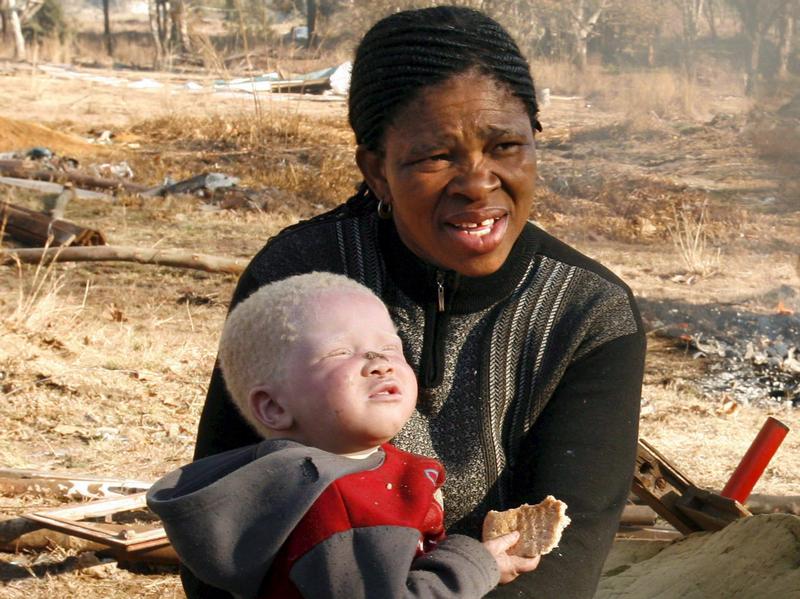

The original Indo-Europeans referred to, as Aryans were nomads who herded animals in the steppes north of the Black Sea, in what is now the Ukraine. Between 5,000 and 6,000 years ago, the Aryans migrated into Europe on horseback and conquered a series of cultures. The Encyclopedia Britannicaconcurs with British historians. When trying to trace pre-historic man to Europeans, it was found that Indo-Iranian languages make up a major branch of the Indo-European family of languages (Bower, 120+).
The Sinhalese Language is an Indo-European language of the Indo-Aryan family. The earliest surviving specimens of the language are brief inscriptions on rocks in Brahmi Letters from 200 BC. The most considerable amount of dated Aryan language dates to about AD 1000 (Encyclopedia Britannica, 567).
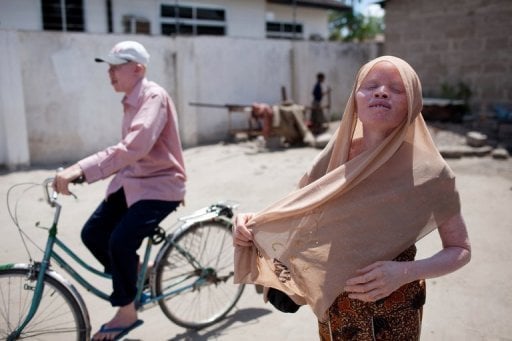

Linguistics link the Iranian language to African languages. Iranian languages include the Arabic language. Arabic belongs to the Semitic language group. Semitic includes Ethiopic and Hebrew--people who lived in one of Black Africa's greatest civilizations. The implication being made is the following: Caucasians cannot validate their rudiment White civilization. It has been proven that civilization started in the great river valleys of Africa in the Fertile Crescent. The human race was born in Africa, and it is only logical that the evolution of White men started in Africa.



Tanzanian Albino kid

Snowflake, the only albino gorilla ever observed. Captured from the wild by poachers in 1967, Snowflake, originally from Equitorial giunea forest lived out most of his life at the Barcelona zoo. He died at the ripe old age of 40 due to skin cancer, probably related to his albinism. He outlived all of his 22 children, none of whom were albino, but lived to see his many grandchildren - a rarity for gorillas
The Encyclopedia Britannia outlines the lack of or absence of historical sources to trace the process of Swedish Expansion and the Viking Era around AD 400. The same is true for Denmark. It is written--The first trustworthy written evidence of a kingdom of Denmark belongs to the early Viking Period. Roman knowledge of this country was fragmentary and unreliable. The same is said for the other Scandinavian countries.
Currently, the Smithsonian Museum is inviting people to examine the Atlantic Saga of the well-known culture of the Scandinavian Viking Age (AD750-1050) as they discover America. They landed in Newfoundland, Canada exactly 1,000 years ago. It is being hailed as a "discovery." An endnote has been added that there is generous support from the Nordic Council and Ministers of Volvo.
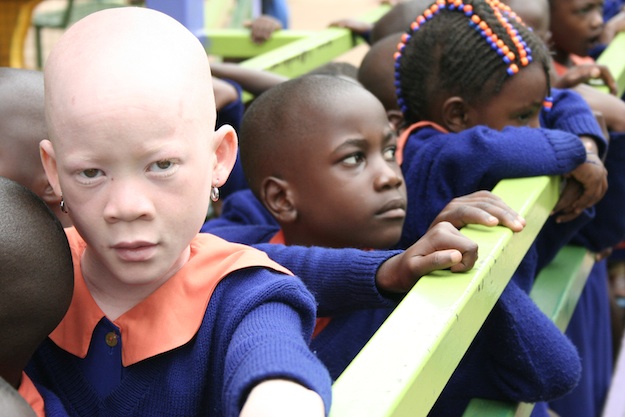

The Caucasoid/8 per centers' numerical deficiency has created a sort of numerical abundance because White groups now have psychologically increased their numbers with the many different White classifications of: German White Race, English White Race, French White Race, and Russian White Race. This justifiably amounts to many White Races even though theoretically there has been a three-race theory staunchly in place since the 19th Century.
The same psychological numerology works to minimize black/brown groups and forms the White "labeled minority classifications" geneticists refer to when "feeling their oats on the genetic highway to a White majority." Dividing black/brown people into groups and referring to the groups as "non-white" or "people of color," presents a purely natural tendency to think of black/brown people as lesser because of the fewest number of numerical classifications. Therefore, Black and Brown people have become minorities in the mastermind scheme when the statistical numbers of abundant craftiness are presented globally.


From sea-to-shining-sea. History shows that discrimination in this country occurs in all races that are not considered Caucasian. Asians, for example, have experienced a long history of discrimination even though the Asian Race is coined as the "Prototype Minority" worthy enough to grace the White American dominion. In 1854 the California Supreme Court ruled that Chinese citizens were not permitted to testify against Whites. In 1882 the Chinese Exclusion Act banned all immigration from China.


In 1913, California declared Asians ineligible for citizenship and prohibited property ownership. In 1924 the National Origins Act excluded most Asians from migrating to the US. With the outbreak of World War II one hundred and ten thousand (110,000) Japanese Americans were relocated to internment camps. It was only in 1952 that Asians born outside the US were permitted to become citizens--but now have been termed the “ideal minority.” Today most Blacks and Latinos continue to be subjected to extreme economic and social discrimination; whereas, most Asian Americans are not. Asian Americans have been labeled the "ideal minority."
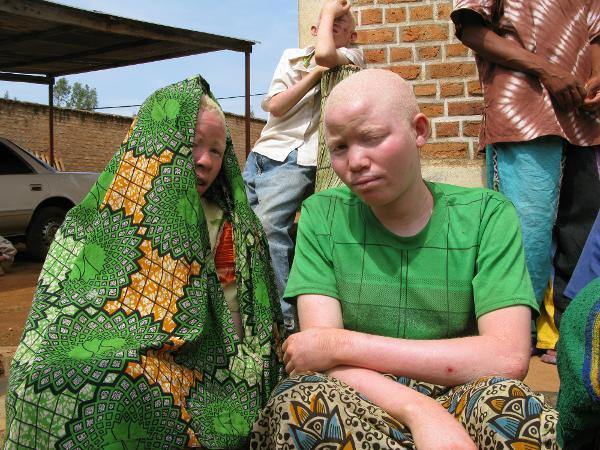

King James invented "discrimination of the divine" when he and his team of 47 European interpreters translated the King James Version of The Holy Bible. Purity, virtue, and goodness spew from every pictorial page of White European Biblical characters. The Bible reveals a blue-eyed White Jesus hanging on a cross, a golden-haired White Moses showing the "Tablets of Law to the People," and praying at Mt. Sinai upon every turn of a page.
I am King James, and I proclaim "Ham, the youngest son of Noah, to be the father of the Black Race."
Ham is the father of the Black Race because he was cursed and "condemned to Hell" states King James and his team of European Interpreters. In Gen. 9:18-29 Ham is the recipient of a curse--"Let Canaan be cursed."
Hey, that means Canaanites were Black. What do ya know!!! Berber describes the indigenous Caucasoid people of Northern Africa in the scholarly White dictionary and encyclopedia, but Berber is defined as people who speak Hammitic/Semitic Languages. Hey, does that mean Berbers were Black? The Cushite (Ethiopian) and ancient Egyptian also spoke Semitic Languages.


Ham--the Originator of the Black Race "the accursed" and all of his descendants will be damned. Eurocentric church officials developed a mind-set of "heathen Blacks" to devise and formulate deceptive historical attitudes and viewpoints.
The Aryan Nation believes its group does the on-going work of Jesus the Christ in re-gathering His people, calling His people to a state for their nation to ring in His Kingdom. The Aryan Nation believes that Adam, man of Genesis, is the placing of the White Race upon this Earth. Not all races descend from Adam. Adam is the father of the White Race only. (Adam in the original Hebrew language is translated: "to show blood in the face; turn rosy." Genesis 5:1).
The Book of Enoch Hamitic/Ethiopic Authorship: The Book of Enoch--which is considered to be the earliest biblical record of antiquity and the earliest book of Hamitic authorship is widely quoted throughout the King James Version of the Bible. The Book of Enoch was found among the Dead Sea Scrolls in the caves of the Qumran. Enoch was Noah’s grandfather and Methuselah’s father. Methuselah was the oldest man in the Bible living to be 969.


After reading the Book of Enoch, it is evident that the entire Creation of Heaven and Earth depicted by King James and his translators has not been taught in America’s churches. Why? Did King James and his translators use manipulatives to gain control and purposely hide Hamitic/Ethiopic authorship? If this book was written before the book of Genesis, and is Hamitic--aren’t we back-to-Black? Webster’s Warped Dictionary verifies that Ham was the Originator of the Black Race. (Brown, Ronald K. BOOK OF ENOCH, San Antonio, Texas 78210).
 |
 |
 |
Reuters Photo - September 2009
Associated Newspapers, LTD
Black Brazilian Parents have three Albino Children
|
According to the Enoch--one of the Lost Books of the Bible, there were a Race of Angels numbering 200 who were sent to Earth to watch over mankind. The “Watchers” looked upon the women of the Earth and found them fair and pleasing to the eye. The women gave birth to what is known as (Nephilims) Giants of the Earth. The Book of Enoch comprises the following topics:
- Second Coming of Jesus Christ and Judgment
- Skills and Knowledge Taught by the Fallen Angels
- Children of Angels to be destroyed
- Disobedient Angels Incarcerated Till Judgment Day
- Prophecy of A New Heaven and A New Earth
- MESSIANIC REVELATIONSPROPHECIES OF THE RESURRECTION OF THE DEAD
- GOD Promises to Dwell with the Saints
The King James Version of the Bible starts with Genesis and the creation of Heaven and Earth. In Genesis 4:15 God orders Cain out of the Garden of Eden. Cain goes out from the presence of the LORD, and dwells in the land of Nod, on the East of Eden. There he knew his wife and conceived. “The Land of Nod” appears right there in the Fourth Chapter of Genesis. If Adam and Eve were the first two people on earth, what was the Land of Nod? The word “Genesis” is be-rasheet in Hebrew, an African/Edenic language that Western philologists in the 18th Century classified as part of the family of languages. Be-rasheet means “in the beginning” in a time when God created all things. (African Heritage Bible, 1).


Leprosy among the Hebrews and Snow White Miriam
In 14th century B.C., plagues were endemic through the Middle East and Egypt. The Book of Numbers tells us that Miriam and Aaron, sister and brother to Moses, revolted against their brother’s leadership. Miriam and Aaron spake against Moses because he had married an Ethiopian woman. And they said, Hath the Lord indeed spoken only to Moses? Hath eh not spoken also by us?” Their challenge to Moses angered God. As a punishment “Miriam became leprous, white as snow” (Greenberg, 197).
The original man can be linked directly to the "Neanderthal" and "Cro-Magnon" Man 10,000 years ago through archeological measurements in size and stature to the Bushmen-Hottentot population of South Africa. Any US or European research book or encyclopedia show the reader a White man who is half man and half animal. Charles Darwin (Mr. Charlie) and other evolutionists would rather have the world believe man evolved from apes than from a Black man.


As Europeans were busy labeling the entire Black Race as cursed and accursed, a fair-haired English physicist came up with the color spectrum in 1666 that disputes the "White European Hamitic Theory." The theory clearly denotes that if Noah and his wife were Caucasoid, it would have been impossible to produce three different races of people. The Keys to the Colors Theory was proven by Newton over 300 years ago, but Warped Webster's Dictionary still defines Ham as the "Father of the Black Race."
Reference books will tell you the majestic Sir Isaac Newton was credited with the discovery of the color spectrum. The theory presents solid proof that black is the foundation or base for all colors. Newton was the celebrated White English physicist who took a glass prism and passed a beam of sunlight through it. When the light passed through the prism, it formed a rainbow he later called the color spectrum.
By mixing the three primary colors of red, blue, and yellow together, the color black is produced. Black is the color from which all other colors are produced and is dominant. White, on the other hand, is the color of maximal lightness from which no other colors can be produced and is recessive. Just because white reflects all colors does not mean it is possible to get all colors from white. A little every day thing like the exalted Sir Isaac Newton's so called discovery of the color spectrum shows more validity as it points to an African origin than the many years of research and long drawn out scientific theories to disparage and dismiss Black culture and history.


Congolese Albino rapper N`kashh
While scientists interpret, record, and test their theories, all they need is a small box of Crayola Crayons containing three crayons and a sheet of paper to prove the Keys to the colors.
Albinos occur in all races of mankind and in all animal groups. The albionotic condition arises from a distinct hereditary interference with the normal function of melanocytes. The enzyme tyrosinase is necessary for the formation of melanin and determines the color of the skin, hair, and eyes. Most children with albinism are born to parents who have normal hair and eye color for their ethnic backgrounds.
White skin is a form of albinism. There is no difference, microscopically speaking, between the white skin of a Caucasoid person and the skin of a person designated as an Albino. Black people with albinism tend to have hair of a deep bright yellow, cream-colored skin, and green or hazel eyes. The social problems of Blacks are compounded if a child is born and is an Albino. In the Caucasian Race blonde hair, blue eyes, and alabaster skin are considered so highly desirable that brunettes often bleach their hair or wear colored contacts to look like Albinos.


One of the most glorious periods of English History was that of the reign of Queen Victoria (1819-1901). The Victorians wore white wigs and powdered their skin to a chalky white probably in awe of their ancestors. Similarly, the powdered white wig worn by American colonial era illuminati reflected the wearer's ability to afford luxury items and identified him as one of the educated elite.
In Biblical times people with albinism were banished or thrown out, and forced to live in colonies just as people with leprosaria or Hansen's Disease were forced to live in leper colonies and away from other people. The Black Race believed that God was delivering judgment on a family with albinism and that the individual with albinism is cursed or is the embodiment of sin.
White-skinned people came into existence thousands of years ago as the Albino mutant offspring of black-skinned mothers and fathers in Africa. A sizable number of these Black parents produced, rejected and then cast out of the community their genetic defective albino offspring to live away from the normal black skin-pigmented population. There were colonies of albinos formed which eventually migrated northward to Europe, to escape the intensity of the equatorial sun of the Southern hemisphere (Welsing, 23).


During Biblical times Albinos were ostracized. The same thing is happening today when Albinism occurs in society. Albinos are ostracized by their own families--especially in Black families where the difference in skin color is more distinct. The ostracizing of Albinos during Biblical times is the only logical explanation of how the White Race came into existence. The Albino colonies produced more and more Albinos until there was an Albino Race.


The Finnish, Swedish, and Danish people are "as White as pure driven show" with blonde hair that is almost White. The two groups of people show a strong evidence they were part of the composition of the Albinic/White Race that moved northward. White European geneticists that the union of two albinos will produce children that are affected with albinism have validated it. The parents of albinos are often consanguineous since it increases the likelihood that both will possess the same gene. The Albion ticcondition creates an extreme sensitivity of eyes and skin to the sunlight.
There was a migration of the African Albinos northward to what the world recognizes as Europe. During Biblical times Europe was part of Africa. Europeans themselves designated and divided Africa into the regions of the "Middle East" and "Europe."
Skin color is determined by melanin. The large molecule of the pigment melanin is formed in the skin cells from a much smaller molecule called tyrosine. Tyrosine is colorless and is present in all cells. In the skin cells of most human beings there is at least one gene whose job is to manufacture tyrosine. If the gene is of a type that can form considerable quantities of tyrosinase, the skin cell is like a well-staffed factory.


Considerable quantities of melanin are formed, and the person possessing that gene has dark-brown skin, black hair, and dark-brown eyes. If the gene were a type that manufactured only a small amount oftyrosinase, the reverse would be true. Little melanin would be formed, and the person would have fair skin, light hair, and light eyes.
An Albino's genes do not form tyrosinase at all. No tyrosinase occurs in their cells and no melanin can be formed. Such people have very fair skin, white hair, and no pigment at all in their eyes. The eyes look reddish because small blood vessels can be seen through the transparent colorless iris of the eye (Boyd & Asimov, 72).
Classification of albinism
Traditionally, albinism has been classified according to clinical phenotype, and the 2 main categories are oculocutaneous albinism (OCA) and ocular albinism (OA).
The albinism subtypes were reclassified in 2009. With the availability of new molecular genetic studies, the classification of albinism has shifted emphasis to genotype as opposed to phenotype alone.[1] Hence, this has led to redefining existing phenotypic categories and the addition of new subtypes based on specific genetic mutations. The following is a brief overview of the current classification of albinism.
OCA is characterized by the reduction or absence of melanin in the skin, hair, and optic system (including the eyes and optic nerves). The lack of skin pigment results in a pale skin appearance and an increased risk of skin cancer. As shown in Table 1, OCA is divided further into several subtypes based on the distinct genetic mutation.
Table 1. Oculocutaneous Albinism Types (Open Table in a new window)
| OCA Subtypes | Gene Position | Affected Protein |
OCA 1
| 11q14-21 | Tyrosinase |
| OCA 2 (tyrosinase-positive OCA, brown OCA) | 15q11-13 | P protein |
| OCA 3 | 9p23 | Tyrosinase-related protein |
OA is characterized by changes in the optic system only with no clinical difference in skin and hair color. As shown in Table 2, two major disorders exist in this category, ocular albinism 1 (OA 1) and autosomal recessive ocular albinism (AROA).
Table 2. Ocular Albinism Types (Open Table in a new window)
| OA Subtypes | Gene Position | Affected Protein |
| OA 1 (X-linked recessive OA/Nettleshop-Falls type) | X p22.3-22.2 | The protein product of the OA 1 gene named OA 1 (and also identified as GPR143 in GenBank)[2, 3] |
| AROA | Not a distinct position | Tyrosinase in some cases; P protein in some cases |
The research work below done on albinism in Africa would be of beneficial importance to people living in Africa and overseas and are interested in educating some African society where individuals see albinos as potent ritual body-parts. The problem that albinos face in Africa is not actually about their hatred for albinos but rather it is being fueled by the so-called potency of their body-parts in rituals. So the education should rather be on the health implications of one giving birth to albinos.
| source:http://www.biomedcentral.com/1471-2458/6/212/#B11 | ||
 | ||
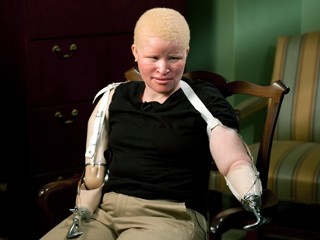  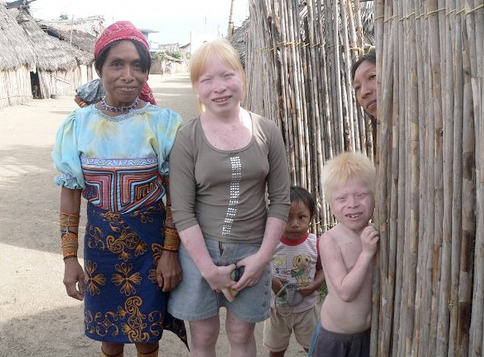 Panama albino  |






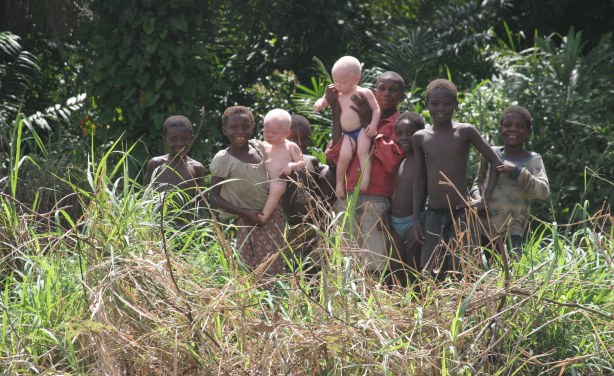


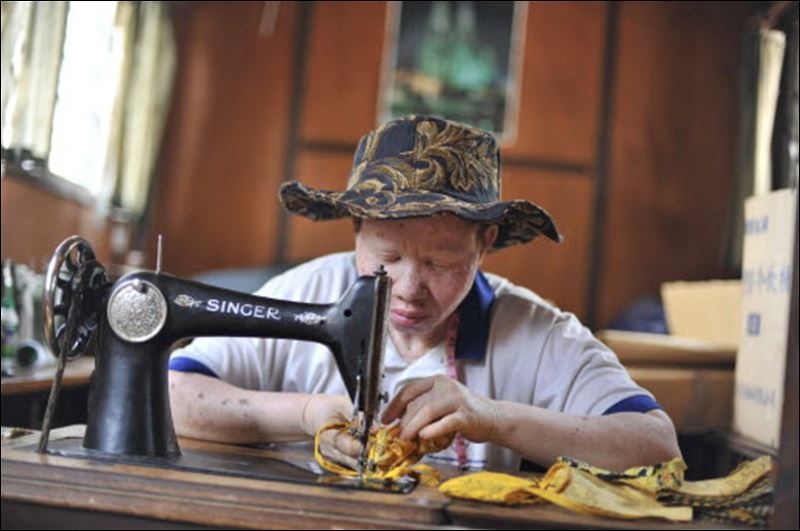




















 s
s






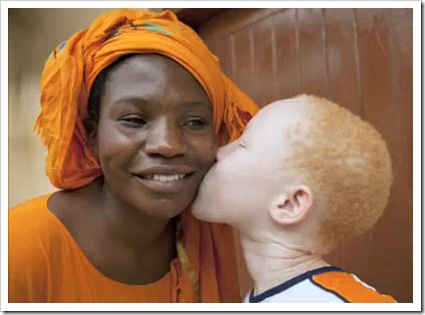

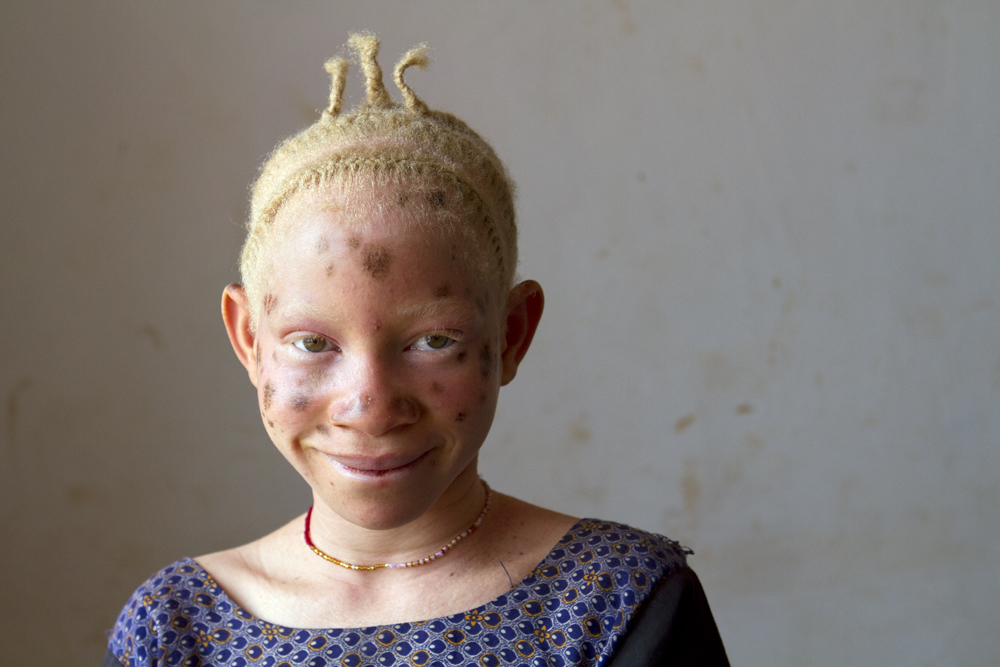
 ublic health programmes and intervention recommendations
ublic health programmes and intervention recommendations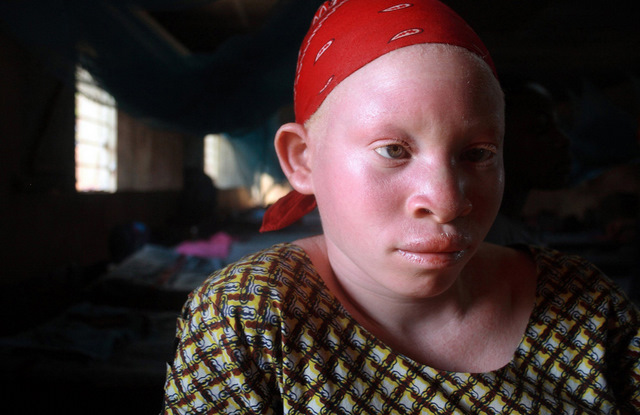
 Integrate albinism awareness in the school curricula, especially to correct misconceptions about the etiology of albinism
Integrate albinism awareness in the school curricula, especially to correct misconceptions about the etiology of albinism

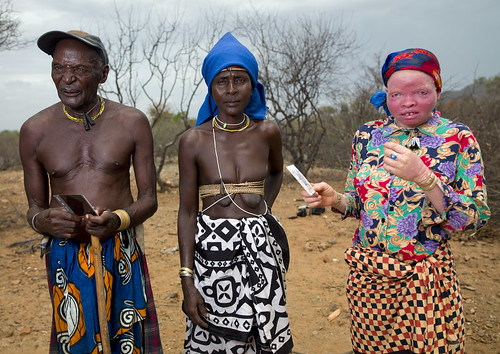


No comments:
Post a Comment